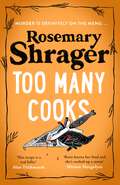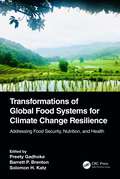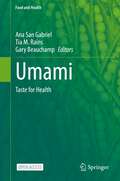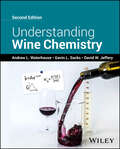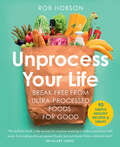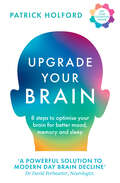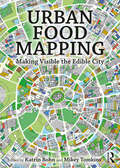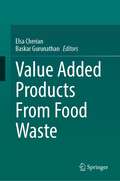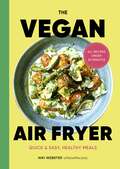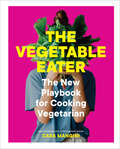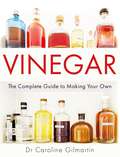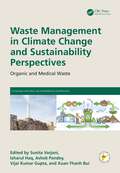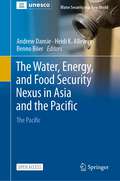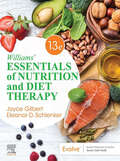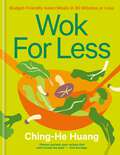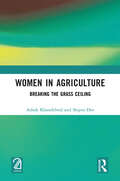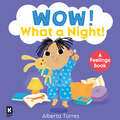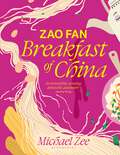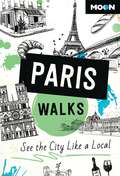- Table View
- List View
Think Like a Dietitian: A Nutrition Counseling Starter Kit
by J. Barretto PattersonWhile courses in nutrition counseling teach providers to listen to their patients, this book gives registered dietitian nutritionists (RDNs) a heads-up on what to listen for, with educational materials that address the everyday challenges many people, hence many RDNs, face.Split into four distinct sections, this book equips readers with comprehensive education and counseling for the most common nutrition referrals.Topics include:- How to structure a nutrition counseling session, from getting a patient to open up to empowering them with information and strategies for self‑care.- Strategies for the provider to address personal challenges such as cultivating empathy, implicit bias, and cultural competence.- Routine eating patterns and challenges reported in nutrition counseling, such as night eating, emotional eating, and more.- Common reasons for referral to a dietitian, and frequently asked questions on topics including diabetes, heart disease, kidney disease, irritable bowel syndrome, and weight counseling.- Special issues in health educationThis book is appealing to both early nutrition professionals and experienced dietitians alike, providing a holistic tool kit for RDNs of all levels of experience.
Too Many Cooks: Prudence Bulstrode 3 (Prudence Bulstrode)
by Rosemary ShragerPrudence Bulstrode has fond memories of St Marianne's School for Girls, the beautiful Cornish school where she boarded as a girl. It was at St Marianne's that Prudence first learned the joy of cooking, from her dear old Home Economics teacher, Mrs Agatha Jubber. So when she's invited back to the school, to lead a summer holidays course in the fundamentals of cookery, Prudence couldn't be more delighted. What's more, it's a chance to show her grand-daughter Suki the way school used to be in the good old days.But no sooner has Prudence arrived at St Marianne's, a gruesome discovery is made. The builders excavating the old hockey pitch to construct the new dormitories have unearthed human bones - bones dating from Prudence's own time at St Marianne's. Soon, Prudence recollects the story of the vanishing schoolmaster, Mr Scott, and the rumours that spread like wildfire one summer about his illicit affair with Agatha Jubber.So begins Prudence's very first cold case . . .
Transformations of Global Food Systems for Climate Change Resilience: Addressing Food Security, Nutrition, and Health
Transformations of Global Food Systems for Climate Change Resilience: Addressing Food Security, Nutrition, and Health provides poignant case studies of climate change resilience frameworks for nutrition-focused transformations of agriculture and food systems, food security, food sovereignty, and population health of underserved and marginalized communities from across the globe. Each chapter is drawn from diverse cultural contexts and geographic areas, addressing local challenges of ongoing food and health system transformations and illustrating forms of resistance, resilience, and adaptations of food systems to climate change. Fourteen chapters present global case studies, which directly address the United Nations Sustainable Development Goals and the Food and Agriculture Organization’s global call to action for transforming agriculture, addressing food security and nutrition, and the health of populations impacted by climate change and public health issues.They also integrate reflections, insights, and experiences resulting from the COVID-19 Pandemic. This edited volume includes research on (1) enhancing food sovereignty and food security for underserved populations with a particular focus on indigenous peoples; (2) improving locally contextualized definitions and measurements of climate change resilience, food security, hunger, nutrition, and health; (3) informing public health programs and policies for population health and nutrition; and (4) facilitating public and policy discourse on sustainable futures for community health and nutrition in the face of climate change and natural disasters, including ongoing and future pandemics or emergencies. Within this book, readers discover an array of approaches by the authors that exemplify the mutually engaged and reciprocal partnerships that are community-driven and support the positive transformation of the people with whom they work. By doing so, this book informs and drives a global sustainable future of scholarship and policy that is tied to the intersectionality and synergisms of climate change resilience, food security, food sovereignty, nutrition, and community health.
Transformations of Global Food Systems for Climate Change Resilience: Addressing Food Security, Nutrition, and Health
by Preety Gadhoke Barrett P. Brenton Solomon H. KatzTransformations of Global Food Systems for Climate Change Resilience: Addressing Food Security, Nutrition, and Health provides poignant case studies of climate change resilience frameworks for nutrition-focused transformations of agriculture and food systems, food security, food sovereignty, and population health of underserved and marginalized communities from across the globe. Each chapter is drawn from diverse cultural contexts and geographic areas, addressing local challenges of ongoing food and health system transformations and illustrating forms of resistance, resilience, and adaptations of food systems to climate change. Fourteen chapters present global case studies, which directly address the United Nations Sustainable Development Goals and the Food and Agriculture Organization’s global call to action for transforming agriculture, addressing food security and nutrition, and the health of populations impacted by climate change and public health issues.They also integrate reflections, insights, and experiences resulting from the COVID-19 Pandemic. This edited volume includes research on (1) enhancing food sovereignty and food security for underserved populations with a particular focus on indigenous peoples; (2) improving locally contextualized definitions and measurements of climate change resilience, food security, hunger, nutrition, and health; (3) informing public health programs and policies for population health and nutrition; and (4) facilitating public and policy discourse on sustainable futures for community health and nutrition in the face of climate change and natural disasters, including ongoing and future pandemics or emergencies. Within this book, readers discover an array of approaches by the authors that exemplify the mutually engaged and reciprocal partnerships that are community-driven and support the positive transformation of the people with whom they work. By doing so, this book informs and drives a global sustainable future of scholarship and policy that is tied to the intersectionality and synergisms of climate change resilience, food security, food sovereignty, nutrition, and community health.
Umami: Taste for Health (Food and Health)
by Ana San Gabriel Tia M. Rains Gary BeauchampThis Open Access book covers the concept of umami, the unique taste imparted by the amino acid glutamate, was first described in 1908 by Dr. Kikunae Ikeda of Tokyo University. Over the past century, hundreds of studies have explored the mechanistic underpinnings of the taste, leading to the characterization of the umami taste receptor in 2002. How this fifth basic taste figures into nutrition and health, however, remains underexplored.Umami: Taste for Health provides an overview of the relationship between umami and human health. Authors explain how glutamate not only produces a characteristic oral sensation in the mouth but also functions as a signaling molecule to induce physiological responses. With the support of recent studies, the book demonstrates how the taste properties of umami make glutamate a promising substance to lower salt intake, promote satiation and support healthier aging. The text also covers practical culinary applications to increase umami flavor and practical usage of umami for promoting healthy eating.Provides an overview of the relationship between umami and human health;Explores the potential of glutamate to lower salt intake, promote satiation and support healthier aging;Covers practical culinary applications of umami flavor and practical usage of umami for promoting healthy eating.
Understanding Wine Chemistry
by Andrew L. Waterhouse Gavin L. Sacks David W. JefferyUnderstanding Wine Chemistry Understand the reactions behind the world’s most alluring beverages The immense variety of wines on the market is the product of multiple chemical processes – whether acting on components arising in the vineyard, during fermentation, or throughout storage. Winemaking decisions alter the chemistry of finished wines, affecting the flavor, color, stability, and other aspects of the final product. Knowledge of these chemical and biochemical processes is integral to the art and science of winemaking. Understanding Wine Chemistry has served as the definitive introduction to the chemical components of wine, their properties, and their reaction mechanisms. It equips the knowledgeable reader to interpret and predict the outcomes of physicochemical reactions involved with winemaking processes. Now updated to reflect recent research findings, most notably in relation to wine redox chemistry, along with new Special Topics chapters on emerging areas, it continues to set the standard in the subject. Readers of the second edition of Understanding Wine Chemistry will also find: Case studies throughout showing chemistry at work in creating different wine styles and avoiding common adverse chemical and sensory outcomes Detailed treatment of novel subjects like non-alcoholic wines, non-glass alternatives to wine packaging, synthetic wines, and more An authorial team with decades of combined experience in wine chemistry research and education Understanding Wine Chemistry is ideal for college and university students, winemakers at any stage in their practice, professionals in related fields such as suppliers or sommeliers, and chemists with an interest in wine.
Understanding Wine Chemistry (Sci (society Of Chemical Industry) Ser.)
by Andrew L. Waterhouse Gavin L. Sacks David W. JefferyUnderstanding Wine Chemistry Understand the reactions behind the world’s most alluring beverages The immense variety of wines on the market is the product of multiple chemical processes – whether acting on components arising in the vineyard, during fermentation, or throughout storage. Winemaking decisions alter the chemistry of finished wines, affecting the flavor, color, stability, and other aspects of the final product. Knowledge of these chemical and biochemical processes is integral to the art and science of winemaking. Understanding Wine Chemistry has served as the definitive introduction to the chemical components of wine, their properties, and their reaction mechanisms. It equips the knowledgeable reader to interpret and predict the outcomes of physicochemical reactions involved with winemaking processes. Now updated to reflect recent research findings, most notably in relation to wine redox chemistry, along with new Special Topics chapters on emerging areas, it continues to set the standard in the subject. Readers of the second edition of Understanding Wine Chemistry will also find: Case studies throughout showing chemistry at work in creating different wine styles and avoiding common adverse chemical and sensory outcomes Detailed treatment of novel subjects like non-alcoholic wines, non-glass alternatives to wine packaging, synthetic wines, and more An authorial team with decades of combined experience in wine chemistry research and education Understanding Wine Chemistry is ideal for college and university students, winemakers at any stage in their practice, professionals in related fields such as suppliers or sommeliers, and chemists with an interest in wine.
Unprocess Your Life: Break Free From Ultra-processed Foods For Good
by Rob Hobson‘This brilliant book is the answer for anyone wanting to make a profound shift away from eating ultra-processed foods, but just doesn’t know where to start’ – Dr Hilary Jones
Upgrade Your Brain: Unlock Your Life’s Full Potential
by null Patrick HolfordDo you often feel exhausted and negative? Do you spend your days feeling tired and wired? Your nights unable to fall asleep easily, or without a drink? Do you wake up anxious and stressed and in need a coffee to get going? Do you forget what you were doing, forget people’s names and where you put things? Is your mental acuity and memory slipping? Are you concerned about your memory or mental wellbeing? Something depressing is happen to humanity, and possibly even you. Our brains are degenerating and – in parallel – we’re seeing a worrying increase in mental illness across the world. Rates of anxiety, depression, dementia, ADHD and autism are all increasing at an alarming rate across the globe. According to the World Health Organisation, our declining brain health is the greatest threat we face – more than cancer, diabetes or obesity. Individually and collectively,though, we can optimise our brain health and cognitive function – to improve mood, memory, stress resilience, sleep and ability to focus. How? By understanding the powerful effects that nutrition and other holistic lifestyle factors can have on our brains. In Upgrade Your Brain, bestselling author Patrick Holford will draw on his 40 years’ of expertise – as well as countless experts from around the world – to teach us all how to reverse the tide.
Urban Food Mapping: Making Visible the Edible City
by Katrin Bohn Mikey TomkinsWith cities becoming so vast, so entangled and perhaps so critically unsustainable, there is an urgent need for clarity around the subject of how we feed ourselves as an urban species. Urban food mapping becomes the tool to investigate the spatial relationships, gaps, scales and systems that underlie and generate what, where and how we eat, highlighting current and potential ways to (re)connect with our diet, ourselves and our environments.Richly explored, using over 200 mapping images in 25 selected chapters, this book identifies urban food mapping as a distinct activity and area of research that enables a more nuanced way of understanding the multiple issues facing contemporary urbanism and the manyfold roles food spaces play within it. The authors of this multidisciplinary volume extend their approaches to place making, storytelling, in-depth observation and imagining liveable futures and engagement around food systems, thereby providing a comprehensive picture of our daily food flows and intrastructures. Their images and essays combine theoretical, methodological and practical analysis and applications to examine food through innovative map-making that empowers communities and inspires food planning authorities. This first book to systematise urban food mapping showcases and bridges disciplinary boundaries to make theoretical concepts as well as practical experiences and issues accessible and attractive to a wide audience, from the activist to the academic, the professional and the amateur. It will be of interest to those involved in the all-important work around food cultures, food security, urban agriculture, land rights, environmental planning and design who wish to create a more beautiful, equitable and sustainable urban environment.
Urban Food Mapping: Making Visible the Edible City
by Katrin Bohn Mikey TomkinsWith cities becoming so vast, so entangled and perhaps so critically unsustainable, there is an urgent need for clarity around the subject of how we feed ourselves as an urban species. Urban food mapping becomes the tool to investigate the spatial relationships, gaps, scales and systems that underlie and generate what, where and how we eat, highlighting current and potential ways to (re)connect with our diet, ourselves and our environments.Richly explored, using over 200 mapping images in 25 selected chapters, this book identifies urban food mapping as a distinct activity and area of research that enables a more nuanced way of understanding the multiple issues facing contemporary urbanism and the manyfold roles food spaces play within it. The authors of this multidisciplinary volume extend their approaches to place making, storytelling, in-depth observation and imagining liveable futures and engagement around food systems, thereby providing a comprehensive picture of our daily food flows and intrastructures. Their images and essays combine theoretical, methodological and practical analysis and applications to examine food through innovative map-making that empowers communities and inspires food planning authorities. This first book to systematise urban food mapping showcases and bridges disciplinary boundaries to make theoretical concepts as well as practical experiences and issues accessible and attractive to a wide audience, from the activist to the academic, the professional and the amateur. It will be of interest to those involved in the all-important work around food cultures, food security, urban agriculture, land rights, environmental planning and design who wish to create a more beautiful, equitable and sustainable urban environment.
Value Added Products From Food Waste
by Elsa Cherian Baskar GurunathanThe rapid increase in industrial processes for the preparation and processing of various food products have resulted in the creation of large quantities of waste. These food wastes contain large amounts of nutrients which can be further converted into useful products, making byproduct technology increasingly important.Byproducts produced from various agro-based industries like cereals, fruits, vegetable processing, fish, meat and poultry can be converted into beneficial products. For instance, cereal and legume processing produces large quantities of wastes which can result in environmental problems affecting air, soil and water quality. These wastes can be efficiently utilized and converted into value added products such as bioethanol, butanol, biohydrogen, biogas, biocoal, industrially treasured enzymes, biofertilizer, proteins and organic acids. Value Added Products From Food Waste covers waste management techniques utilized for managing raw materials in the food industry in an efficient way, recovering and reusing waste or neutralizing unwanted components. Chapters focus on the latest technologies and efficient management systems in all areas of food processing that make this process economical and minimize the hazards caused by the deposition of waste. From the dairy industry to cereals to fruits and vegetables to fish, each aspect of the food industry is examined with an eye for how to utilize food waste, transforming these wastes into value added products.
The Vegan Air Fryer: Quick & easy, healthy meals
by Niki WebsterHealthy Eating Made Simple.This quick-and-easy cookbook makes healthy meal prep, and eating more veg, effortless.Everyone will love these delicious, vibrant breakfasts, snacks, lunches, dinners, baking and desserts cooked in your air fryer. If you’re new to vegan eating or have just got an air fryer, this book is for you.Find 70 plant-based recipes for beginners. Enjoy cooking:- Easy breakfasts- Simple lunches & light bites- Super quick meals – ready in 15 minutes or less- 30-minute meals - Bread, cakes, cookies & desserts
The Vegetable Eater: The New Playbook for Cooking Vegetarian
by Cara ManginiThe IACP Award–winning author of The Vegetable Butcher presents simple lessons and 100 recipes that put irresistible, vegetable-forward dishes in every home cook&’s everyday rotation. The Vegetable Butcher is back! With simple lessons and recipes that put irresistible, vegetable-forward dishes in every home cook&’s everyday rotation. IACP Award winner and James Beard Award finalist Cara Mangini (The Vegetable Butcher) presents a foundational education in vegetable cooking in an eminently approachable framework—through uncomplicated lessons with seasonal riffs (think a Vegetable Grain Bowl, Hearty Entrée Salad, or Frittata, each with variations for spring, summer, and fall). 35 essential dishes. 3 seasonal variations. More than 100 simple, nourishing, vegetable-forward recipes to put on repeat.
Vinegar: The Complete Guide to Making Your Own
by Caroline GilmartinIn this book, fermented foods expert Dr Caroline Gilmartin details the production of vinegar from start to finish, covering a variety of methods for a range of skill levels. Learn how to make your own vinegars, from apple cider to raisin, in your familiar home environment, from the simplest low-intervention processes to more technical ones. The origins and development of this well-loved condiment remain a mystery to many, so a rundown of vinegar's history is provided. It takes an in-depth look at some of the world's most famous vinegars that will motivate you and inspire your own creations.
Waste Management in Climate Change and Sustainability Perspectives: Organic and Medical Waste (Sustainable Industrial and Environmental Bioprocesses)
by Sunita Varjani Izharul Haq Ashok Pandey Vijai Kumar Gupta Xuan-Thanh BuiThis handbook discusses the relationships and effects of climate change on waste treatment and its sustainable management. The waste management sector is in a unique position to transition from a minor source of global greenhouse gas (GHG) emissions to a major contributor to reducing GHG emissions. This book compiles the potential impacts and benefits of various waste management systems in terms of climate impact. It investigates the global climate impact of municipal solid waste, commercial and industrial waste, agricultural waste, and hazardous waste management systems.Key features: Reviews advanced and innovative processes for sustainable waste management Covers green waste treatment technologies using microbes, green soldier flies, earthworms and bacteriophages Discusses the negative and positive effects of waste treatment and disposal Provides relevant case studies from different regions of the world Examines the role of climate change on emerging pollutants The book is meant for researchers and professionals in environmental sciences, chemical and biochemical engineering.
Waste Management in Climate Change and Sustainability Perspectives: Organic and Medical Waste (Sustainable Industrial and Environmental Bioprocesses)
by Sunita Varjani Izharul Haq Ashok Pandey Vijai Kumar Gupta Xuan-Thanh BuiThis handbook discusses the relationships and effects of climate change on waste treatment and its sustainable management. The waste management sector is in a unique position to transition from a minor source of global greenhouse gas (GHG) emissions to a major contributor to reducing GHG emissions. This book compiles the potential impacts and benefits of various waste management systems in terms of climate impact. It investigates the global climate impact of municipal solid waste, commercial and industrial waste, agricultural waste, and hazardous waste management systems.Key features: Reviews advanced and innovative processes for sustainable waste management Covers green waste treatment technologies using microbes, green soldier flies, earthworms and bacteriophages Discusses the negative and positive effects of waste treatment and disposal Provides relevant case studies from different regions of the world Examines the role of climate change on emerging pollutants The book is meant for researchers and professionals in environmental sciences, chemical and biochemical engineering.
The Water, Energy, and Food Security Nexus in Asia and the Pacific: The Pacific (Water Security in a New World)
by Andrew Dansie Heidi K. Alleway Benno BöerThis open access book considers the water, energy, food (WEF) nexus in the Pacific region. The region comprises seventeen sovereign countries and seven territories spread across the Pacific Ocean, a blue expanse that covers a fifth of the world’s surface area but contains only 0.5% of the population—or 44.5 million people. The uniqueness of the Pacific and the need for a Pasifika-led approach to sustainability across environmental, societal and economical spheres requires this blue continent to be considered in a separate volume under the ‘Water Security in a New World’ series.This Pacific volume is focussed on water, energy and food security in Pacific Island Countries and Territories (PICTs) and the challenges produced by the impacts of anthropogenic climate change and human population pressures. The diversity of culture, traditional knowledge and ways of life across the Pacific are united by similar geographies and opportunities to apply a ‘Pacific specific’ WEF nexus approach; a coordinated approach to manage water, energy and food that is centred on active decision making across the three sectors to increase the security of each. Importantly, a WEF nexus approach builds on national and international efforts to date in the Pacific which include Integrated Water Resource Management, Ridge to Reef, Source to Sea, UNESCO Biosphere Reserves, Integrated Coastal Zone Management and other similar approaches.In this book, contributions by authors from governments, regional bodies, multilateral agencies, and academia describe water security and its intersectionality with both the energy and food sectors, highlighting the significance of both land and marine food systems and connectivity between water and energy in a Pacific-focussed context. It is demonstrated that these systems cannot be separated from the challenges associated with healthy environments and functioning ecological services, transport, and waste that are unique to this vast archipelagic region. To achieve meaningful change, it is essential that solutions are cognizant of the world’s colonial past and the global inequalities that persist today. The path forward for water and food systems is one that is Pasifika-led and builds on traditional knowledge and local capacity. National energy demands must consider the future with solutions comprising both WEF-integrated approaches and new energy technologies to hasten the transition away from fossil fuels. Globally, major greenhouse gas emitters both past and present need to step up for the environmental and economic benefit of all by rapidly reducing greenhouse gas emissions and supporting Pasifika leadership on highly ambitious net zero goals.This book is a highly recommended source of information and inspiration for policy makers, decision makers, research communities and practitioners dealing with any aspect of water, energy, or food security in the Pacific.
Williams' Essentials of Nutrition and Diet Therapy - E-Book: Williams' Essentials of Nutrition and Diet Therapy - E-Book
by Joyce Ann Gilbert Eleanor SchlenkerMaster the essentials of nutrition science and patient care with this concise text! Williams’ Essentials of Nutrition and Diet Therapy, 13th Edition helps you understand and apply nutrition concepts in the treatment of disease, disease prevention, and life enhancement. The text is broken out into three parts: the basics of nutrients and the body, the life cycle and community nutrition, and clinical nutrition. Case studies help you determine nutritional interventions in treating both acute and chronic conditions. Written by nutrition specialists Joyce Gilbert and Eleanor D. Schlenker, this book includes the latest advances in research and evidence-based practice. Strong community focus includes robust coverage of health promotion, cultural competence, patient safety, lifespan, and public health issues. Person-centered approach helps you develop practical solutions to individual problems, based on the authors’ personal research and clinical experience. MyPlate for Older Adults is included, as developed by nutrition scientists at Tufts University and the AARP Foundation, along with the Nestlé Mini Nutritional Assessment Scale. Health Promotion sections help you with nutrition education, stressing healthy lifestyle choices and prevention as the best medicine. Case studies provide opportunities for problem solving, allowing you to apply concepts to practical situations in nutrition care. Evidence-Based Practice boxes emphasize critical thinking and summarize current research findings. Focus on Culture boxes highlight cultural competence and the nutritional deficiencies, health problems, and appropriate interventions relating to different cultural, ethnic, racial, and age groups. Focus on Food Safety boxes alert you to food safety issues related to a particular nutrient, population group, or medical condition. Complementary and Alternative Medicine boxes offer uses, contraindications, and advantages/disadvantages of common types of herbs and supplements, and potential interactions with prescription or over-the-counter medications. Chapter summaries and review questions reinforce your understanding of key concepts and their application. Key terms are identified in the text and defined on the page to help reinforce critical concepts.
Wok for Less: Budget-Friendly Asian Meals in 30 Minutes or Less
by Ching-He Huang'Flavour-packed, easy recipes that won't break the bank' - Tom KerridgeThe wok is an incredibly quick, heat-efficient cooking method - and a lot less expensive (and bulky) than an air fryer. Chinese and Asian cuisines have also always featured recipes that use cheaper ingredients. In Wok for Less, Sunday Times bestselling author Ching-He Huang focuses on these traditional, clever ways to reduce costs - all without scrimping on taste.From creative ways to make fish, seafood and meat go further, to inventive veg-packed dishes that will satisfy the most committed carnivore, and ideas for using storecupboard ingredients to make multiple meals, the recipes will not only bring you joy but will save you both time and money. Praise for Asian Green'There's a lot more than wok-based cooking in this beautifully photographed book.' The Times'The Greens Goddess' Daily MailThe Times Best Food Books of the Year 2021Evening Standard Best Vegetarian Cookbooks 2022
Women in Agriculture: Breaking the Grass Ceiling
by Ashok Khandelwal Shipra DeoThe lives of women in rural India cannot be visualized without agriculture and allied activities. As per census 2011 figures, four out of five women workers in rural India work as agriculture workers, as owner cultivators or as wage workers. This research monograph is about women farmers—women who are engaged primarily in the cultivation of vegetables and fruits and predominantly belong to small and marginal land holdings households. It is the outcome of a baseline survey done in the year 2010-11 in three districts of Uttar Pradesh as part of an action intervention project. Based on the survey findings, it discusses the structural and other factors that promote and perpetuate gender inequality and prevent women from realizing their full potential as farmers; presents the struggles, positive experiences and practices; explores possible interventions at different levels for different stakeholders; and suggests a framework keeping the women's agency/empowerment at center stage while simultaneously enhancing their wellbeing. This title is co-published with Aakar Books. Print editions not for sale in South Asia (India, Sri Lanka, Nepal, Bangladesh, Pakistan and Bhutan)
Women in Agriculture: Breaking the Grass Ceiling
by Ashok Khandelwal Shipra DeoThe lives of women in rural India cannot be visualized without agriculture and allied activities. As per census 2011 figures, four out of five women workers in rural India work as agriculture workers, as owner cultivators or as wage workers. This research monograph is about women farmers—women who are engaged primarily in the cultivation of vegetables and fruits and predominantly belong to small and marginal land holdings households. It is the outcome of a baseline survey done in the year 2010-11 in three districts of Uttar Pradesh as part of an action intervention project. Based on the survey findings, it discusses the structural and other factors that promote and perpetuate gender inequality and prevent women from realizing their full potential as farmers; presents the struggles, positive experiences and practices; explores possible interventions at different levels for different stakeholders; and suggests a framework keeping the women's agency/empowerment at center stage while simultaneously enhancing their wellbeing. This title is co-published with Aakar Books. Print editions not for sale in South Asia (India, Sri Lanka, Nepal, Bangladesh, Pakistan and Bhutan)
Wow! – Wow! What a Night! (Wow!)
by HarperCollins Children’s BooksThe Wow! books are a series of modern first concept books for today’s children! The books put little ones in the centre of the action with relatable experiences that will help foster inclusivity, empathy and discussion. Illustrated by Alberta Torres, illustrator of This Little picture book series.
Zao Fan: Breakfast of China
by Michael ZeeLet Michael Zee, creator of the popular SymmetryBreakfast account, be your knowledgeable guide to breakfast in China. Contains over 40 recipes with QR codes that allow you to watch how the dishes are made in ChinaBreakfast in China is an important affair. At dawn, the streets come alive with vendors setting up for the morning breakfast rush. Each will have their speciality that they make day in, day out, honing their recipe over years, and even generations. Locals are spoilt for choice, with a huge variety of spicy noodles, plump dumplings and fluffy buns all made fresh to order right on their doorsteps.Michael Zee, creator of the popular SymmetryBreakfast account, has eaten his way around China, hunting down the very best versions of these morning favourites and recreating them at home so that you can too. In China, these are recipes devised for speed and convenience and so are also perfect for filling lunches, nourishing dinners and quick and tasty snacks.Why not try:Dan dan mian – Sichuanese street-style noodles with a sesame paste sauceJian bing – savoury filled crêpeXiaolongbao – steamed Shangainese soup dumplingsYoutiao – sweetened fried dough sticks, delicious dipped in fresh soy milk or covered in soft serve ice creamWith Michael as your knowledgeable tour guide, you'll be transported to the bustling streets of China, see the mesmeric pulling of noodles and pleating of dumplings and be fully immersed in one of the most exciting and diverse food cultures in the world.
Moon Paris Walks: See the City Like a Local (Travel Guide)
by Moon Travel GuidesStroll along cobblestone alleys and grand boulevards, discover chic restaurants and trendy shops, and bask in la vie Parisienne like a local: on foot!Walk through the city's coolest neighborhoods like Montmartre, le Marais, Saint Germain, and more, with color-coded stops and turn-by-turn directions Find your scene with top ten lists of the best restaurants, nightlife, museums, and more Get to know the real Paris on six customizable walks: Discover a corner café and people-watch from the terrace over lunch. Wander through the Latin Quarter and stroll through the verdant public gardens. Visit world-famous museums and galleries like the Louvre or shop for vintage designer threads. Browse a Sunday flea market for fresh produce and relax in the park with a baguette and fromage under the gaze of the Eiffel Tower. Linger at a trendy restaurant in the up-and-coming Belleville, sip stylish cocktails by the Seine, and dance the night away at the best clubs in town Escape the crowds at locally-loved spots and under-the-radar favorites Explore on the go with foldout maps of each walking route and a removable full-city map, all in a handy guide that fits in your pocket With creative routes, public transit options, and a full-city map, you can experience Paris at your own pace without missing a beat. Hit the ground running with more Walks guides, like Moon New York City Walks, Moon London Walks, Moon Amsterdam Walks, and Moon Rome Walks.About Moon Travel Guides: Moon was founded in 1973 to empower independent, active, and conscious travel. We prioritize local businesses, outdoor recreation, and traveling strategically and sustainably. Moon Travel Guides are written by local, expert authors with great stories to tell—and they can't wait to share their favorite places with you.

